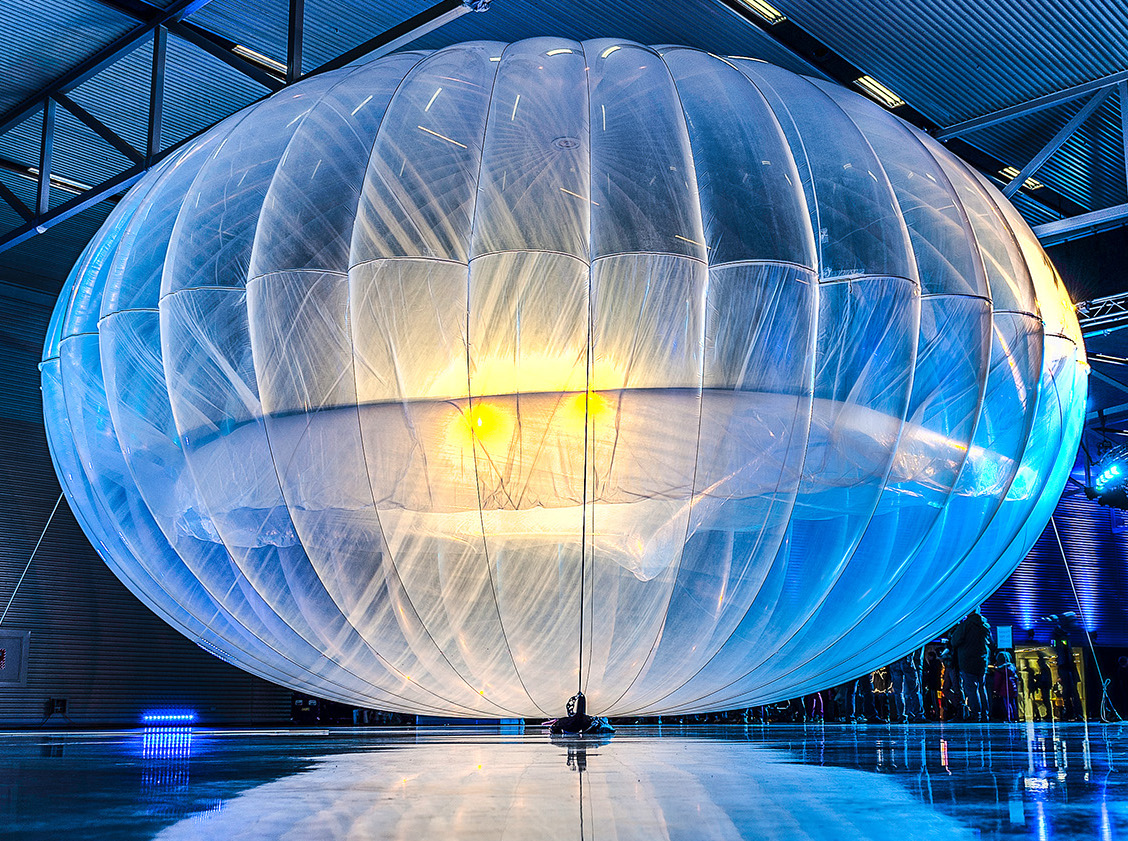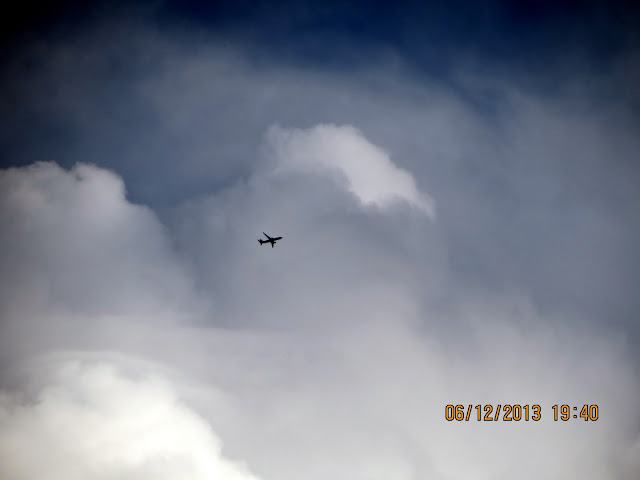Hi Everybody!!
I spy with my own eye is a game I play with the Grandkids. You have to spy something in your eyesight and describe a hint about the object. First one to guess the object wins and becomes the new I spy...! Sometimes, it takes many hints (depending on the age of the child or the grandma!). So tonight your photostudy is what I spied with my own eye in my sky! For months, I have been experiencing more sky traffic than cars on my road. According to the News, we can expect to see more drones also. Your infostudy covers some of the 'sky things'. There is a single greatness now floating around in the sky: Loon Balloons (as you will see below)! Enjoy!!
Current Events In The Sky!
From the Environmental Protection Agency, Check out this link for the Digest and more Info from Whitehouse on Climate Change:
EPA on Twitter Email Summary
06/23/2013
We posted the following to our main Twitter account today: http://www.twitter.com/epagov
Balloons have lifted off!
Google Loon Project:
https://plus.google.com/+ProjectLoon/posts
Project Loon-Up and Away - google.com
www.google.com/loonExplore Google's latest experiment Balloon-powered Internet for all.
8,465 people +1'd this page
http://en.wikipedia.org/wiki/Project_Loon
Project Loon
From Wikipedia, the free encyclopedia
Project Loon is a research and development project being developed by Google with the mission of providing Internet access to rural and remote areas. The project uses high-altitude balloons placed in thestratosphere at an altitude of about 20 km (12 mi) to create an aerial wireless network with up to 3G-like speeds.[1][2][3][4] Because of the project's somewhat outlandish mission goals, Google dubbed it "ProjectLoon".[5]
The balloons are maneuvered by adjusting their altitude to float to a wind layer after identifying the wind layer with the desired speed and direction using wind data from the National Oceanic and Atmospheric Administration (NOAA). Users of the service connect to the balloon network using a special Internet antenna attached to their building. The signal travels through the balloon network from balloon to balloon, then to a ground-based station connected to an ISP, then onto the global Internet. The system aims to bring Internet access to remote and rural areas poorly served by existing provisions, and to improve communication during natural disasters to affected regions.[5][6] Key people involved in the project include Rich DeVaul, chief technical architect, who is also an expert on wearable technology; Mike Cassidy, a project leader; and Cyrus Behroozi, a networking and telecommunication lead.[1]
History[edit]
In 2008, Google had considered contracting with or acquiring Space Data Corp., a company that sends balloons carrying small base stations about 20 miles (32 km) up in the air for providing connectivity to truckers and oil companies in the southern United States, but didn't do so.[7]
Unofficial development on the project began in 2011 under incubation in Google X with a series of trial runs inCalifornia's Central Valley. The project was officially announced as a Google project on 14 June 2013.[1]
On 16 June 2013, Google began a pilot experiment in New Zealand where about 30 balloons were launched in coordination with the Civil Aviation Authority from the Tekapo area in the South Island. About 50 local users in and around Christchurch and the Canterbury Region will test connections to the aerial network using special antennas.[1] After this initial trial, Google plans on sending up 300 balloons around the world at the 40th parallel south that would provide coverage to New Zealand, Australia, Chile, and Argentina. Google hopes to eventually have thousands of balloons flying in the stratosphere at an altitude of 20 km (12 mi).[1][2]
Technology[edit]
The technology designed in the project could allow countries to avoid using expensive fiber cable that would have to be installed underground to allow users to connect to the Internet. Google feels this will greatly increase Internet usage in developing countries in regions such as Africa and Southeast Asia that can't afford to lay underground fiber cable.[8]
The high-altitude balloons fly around the world on the prevailing winds (mostly in a direction parallel with lines of latitude, i.e. east or west). Solar panels about the size of a card table that are just below the free-flying balloons generate enough electricity in four hours to power the transmitter for a day and beam down the Internet signal to ground stations. These stations are spaced about 100 km (62 mi) apart and bounce the signal to other relay balloons that send the signal back down. This makes Internet access available to anyone in the world who has a receiver and is within range to a balloon.[8] Currently, the balloons communicate using unlicensed 2.4 and 5.8 GHz bands,[9] and Google claims that the setup allows it to deliver "speeds comparable to 3G" to users. It is unclear how well technologies that rely on short communications times or pings, such as VoIP, will work given that the signal may have to relay through multiple balloons before reaching the wider Internet.[10]
The first person to connect to the "Google Balloon Internet" after the initial test balloons were launched into the stratosphere was a farmer in the town ofLeeston, New Zealand, who was one of 50 people in the area around Christchurch who agreed to be a pilot tester for Project Loon. The New Zealand farmer lived in a rural location that couldn't get broadband access to the Internet, and had used a satellite Internet service in 2009, but found that he sometimes had to pay over $1000 per month for the service. The locals knew nothing about the secret project, but allowed project workers to attach a basketball-sized receiver resembling a giant bright-red Google map pin to an outside wall of their property in order to connect to the Internet.[8]
The high-altitude balloons fly twice as high as airplanes, but below the range of satellites.[2] Each balloon provides Internet service for an area that covers about 1,250 km2 (480 sq mi).[8]
| Project Loon | |
|---|---|
 | |
| Website | google.com/loon/ |
| Mission statement | Balloon-powered Internet for everyone |
| Commercial? | Yes |
| Type of project | Internet and telecommunication |
| Location | Worldwide |
Drone News:
From the Google Index:
Drones News, Videos, Reviews and Gossip - Gizmodo
gizmodo.com/tag/drones
Confirmed: The FBI is Spying on the US with Drones.
Rand Paul demands FBI explain drone ops - WND
www.wnd.com/2013/06/rand-paul-demands-fbi-explain-drone-ops/
24 mins ago – Rand Paul, R-Ky., has asked the FBI to explain why it is using drones to spy on American citizens, noting that Director Robert Mueller admitted ...
sUAS News | Small Unmanned Aircraft System industry news for ...
www.suasnews.com/
Small Unmanned Aircraft System industry news for professionals • Drones, UAS, ...Despite regulations banning commercial drone use in the United States, ...
FBI under pressure to explain drone use, as Obama ... - Fox News
www.foxnews.com/.../fbi-under-pressure-to-explain-drone-use-as-obama...
4 days ago – As President Obama nominates a new FBI director, the bureau is coming under rising pressure from lawmakers to explain the limits of its ...
http://en.wikipedia.org/wiki/Drone
Drone
From Wikipedia, the free encyclopedia
Vehicles[edit]
- Robot in general
The following post excerpt is from the Blog of sincedutch. Please go to link to see complete article and Blog. One of the most informative Blogs I have seen for staying in touch with current events
http://sincedutch.wordpress.com/2013/06/16/6162013-radar-used-to-transmit-power-several-miles-to-rectenna-experiment-success/
6/16/2013 — RADAR used to transmit power to distant Rectenna — NASA experiment success
2.45GHz @ 500,000watts across several miles.. NASA Goldstone RADAR experiment from 1975.
A fully successful transmission of electricity (wireless) across several miles to a Rectenna.
Also in comparison .. modern day NEXRAD Weather RADAR (used by NWS/NOAA) operates in the 2-3GHz spectrum @ 750,000watts — Which means that, just like the 1975 NASA experiment, our weather RADARs can transmit power (intentionally or unintentionally) to a distant location.
As seen in the video at the top of this post, in 1975 it was possible to transmit power at a distance using 2-3GHz / 500,000watts…. in 1988 the NEXRAD RADAR program was rolled out across the United States operating @ 2-3GHz / 750,000watts.
Meaning we have at least one facility per state (all 50 states) plus several military bases — all capable of transmitting power / electricity wirelessly.
Again we see NEXRAD RADAR has a multiple functionality to it .. first we found it can pulse in the MHz range .. 0-10MHz spectrum.. Just as HAARP in Alaska pulses in the 0-10MHz spectrum. NEXRAD mimicking HAARP.
Next we found that NEXRAD also can target a beam at 2-3GHz, which we further discovered the beam is capable of generating an artificial plasma ‘mirror’ in the atmosphere (called an AIM). NEXRAD mimicking a plasma generator..
The examples listed above are documented here:
Summed up, this 1975 experiment from NASA, proves modern day NEXRAD RADAR is also capable of transmitting electricity across a distance to a receiving antenna ! NEXRAD mimicking a Tesla wireless power transmitter.
...this is brendasue signing off from Rainbow Creek. See You next time! Keep an eye to the sky and one to the news of new things!

http://en.wikipedia.org/wiki/File:Google_Loon_-_Launch_Event.jpg
| Description |
A photo from the Google Loon launch event of June 2013.
| |||||||
| Date | , 13:08:35 | |||||||
| Source | Flickr: Google Loon balloon | |||||||
| Author | Flicker User: iLighter | |||||||
| Permission (Reusing this file) |
|















































































No comments:
Post a Comment
Hi Everybody! Please say hello and follow so I know you are here! Due to the inconsideration of people trying to put commercials on my blog comment area, I have restricted use of anonymous posts. Sorry that some hurt all.
My public email is katescabin@gmail.com No spammers or trolls